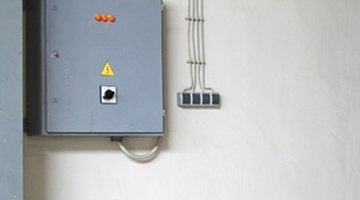How to Install a Miniature Circuit Breaker
Miniature circuit breakers operate just like their larger counterparts but take up just half the space inside a service panel, allowing you to put two breakers in a slot normally used by one. This makes them useful in situations when you want to add a new circuit to a full panel but do not want to go through the trouble of installing a subpanel. While miniature breakers are perfectly safe and approved for use by the National Electrical Code, adding too many new circuits without installing the subpanel can be dangerous. Use miniature breakers only in situations when the new circuits will not overload the panel.
Removing and Replacing a Full-Size Breaker

-
Turn off the power to the panel at the main breaker. Remove the panel cover by unscrewing the fasteners holding it in place. Keep the flashlight nearby as this turns off all power to your home.
-
Remove the full-size breaker by grasping the switch and pulling gently. The breaker will unclip from the hot bus bar without much effort.
-
Disconnect the black wire from the screw terminal on the back of the breaker using a screwdriver. If the breaker is a internal-terminal type, you may need to clip the wire to disconnect the breaker.
-
Attach the black wire to the miniature breaker's terminal and grasp it by the switch portion. Snap the breaker into the slot vacated by the full-size breaker. This replaces the existing circuit.
Adding the New Circuit
-
Knock out an access hole on the service panel with a hammer and screw to allow the cable for the new circuit.
-
Install a metal electrical connector in the access hole with the locknut on the inside and the screw clamps on the outside.
-
Run the cable through the connector, leaving enough wire to reach the bus bars. Wrap the cable around the interior edge of the box to avoid other cables and allow access to the hot bus bars.
-
Attach the black wire of the cable to the miniature breaker and snap the breaker into place as described above.
-
Connect the white wire to a terminal on the neutral bus bar (it is also white). Connect the ground wire to the ground bus bar if present (it is green) or to a vacant terminal on the neutral bus bar if there is no ground bus.
-
Tighten the lock nut on the connector using pliers and the clamp around the cable with a screwdriver.
-
Replace the panel cover and restore power to the panel.
References
- "Wiring"; Creative Homeowner; 2009
- "The Big Book of Home How-To"; Better Homes and Gardens; 2003
Writer Bio
Mark C. Gribben is a writer living near Columbus, Ohio who is a nationally recognized crime historian. Gribben earned his Master's degree in public administration from Michigan State University in 1998.
Photo Credits
- electric panel image by DXfoto.com from Fotolia.com
More Articles



